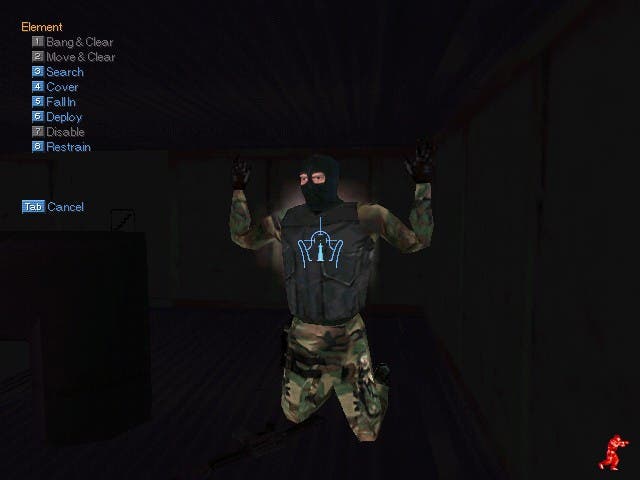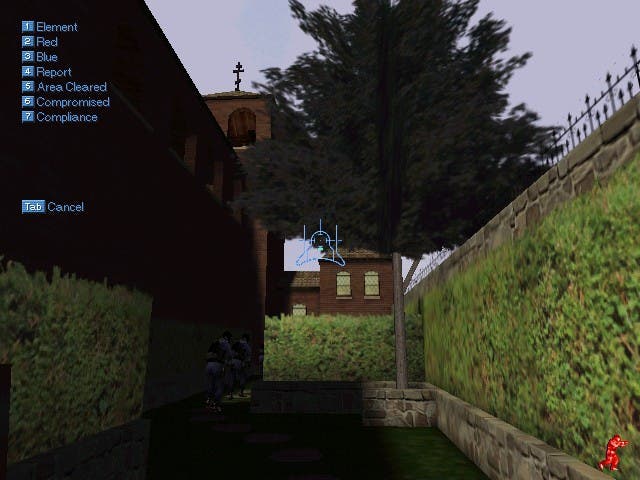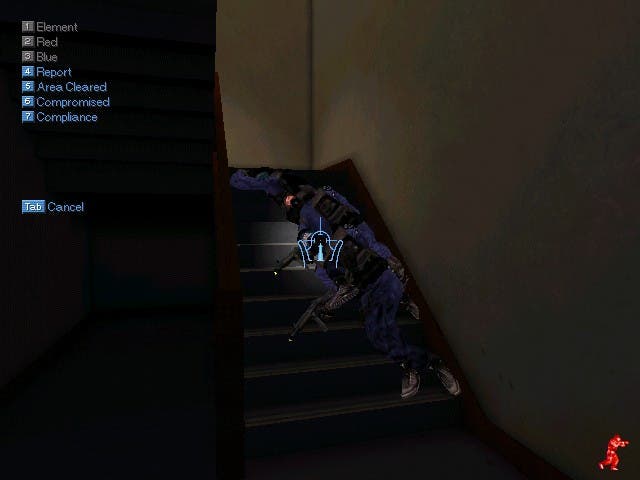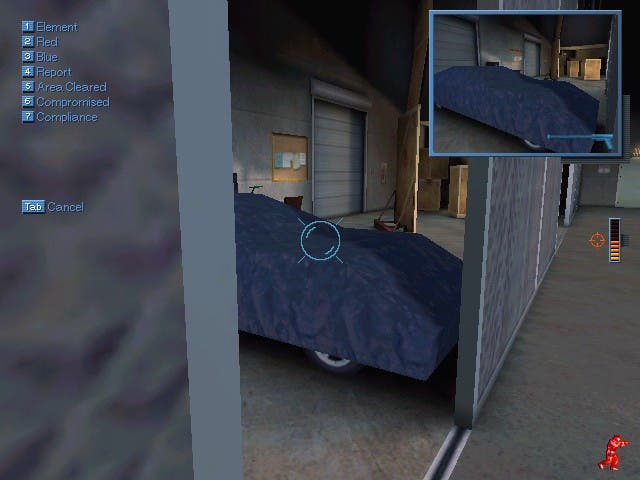SWAT3
Tactical shooter reviewed

Going Tactical
The year is 2005, and the members of the United Nations are about to sign a treaty in Los Angeles to rid the world of nuclear weapons.
Unfortunately the terrorists have no such plans of disarming, and with the world's media focused on LA they are all determined to raise hell and get as much air time as possible. As the leader of a SWAT team it is your job to make sure that they don't interfere with the event.
To make things more interesting, you soon discover that a number of nuclear "suitcase bombs", which have been missing from the Russian arsenal since the early 1990's, are up for auction. It's possible that some of the terrorist groups you are facing may have them...
Unlike the last two games in the series, which were filmed in glorious isometric sprite-o-vision™, SWAT3 is a squad-based first person shooter in the vein of Rainbow 6. But whereas Rainbow 6 was all about meticulous planning, SWAT3 is more about action and team work.
In fact, there is no real pre-mission strategy section at all, which was initially a big disappointment for me. You are given lots of background information, but then the nearest you come to developing any kind of strategy is deciding which rifle or shotgun to carry, whether your men will operate in "dynamic" or "stealth" mode (which you can change on the fly with a single key press once the mission is underway anyway), and occasionally getting a choice between two different entry points. Ooooh.
Devising elaborate and cunning plans was half the fun of Rainbow 6, and without that element SWAT3 felt rather shallow at first.

The Team Works
What I didn't realise was that SWAT3 actually features a sophisticated communications system which allows you to give orders to your team and to communicate with your superiors in the van outside. Unfortunately this isn't explained in any great detail in the manual, and working out how to use it was very much a case of trial and error.
I couldn't work out why the first mission wouldn't end when I achieved my objectives, capturing a suspected sniper and his girlfriend. It was only by accident that I discovered that when you point your crosshair at the suspect a series of new options appear in the comms menu, allowing you to report that you are ready to evacuate him, at which point the mission will end.
Sadly this vital information is hidden away at the bottom of page 40 of the manual, where you will discover that you can also use the same method to order your men to restrain suspects, to call for hostages or wounded officers to be evacuated, to direct your team to search in a particular direction or to breach a door, and to report sightings of suspects.
You can also shout and scream at suspects, who will often surrender given half a chance. The more you shout, flash lights, point guns, and throw gas and "flash bang" grenades at them, the more likely they are to co-operate. It's a nice touch.
Once you have learned to use the communications system to its full potential, the game becomes much more interesting. One of Rainbow 6's failings was that everything was pre-planned and there was no way to deviate from the plan once you had started a mission, short of starting again from scratch. SWAT3 takes completely the opposite view, removing the planning stage entirely and instead leaving you to come up with your own strategy on the fly during the mission.
It's a different approach, and it works surprisingly well under most situations. After a few missions I was merrily reporting casualties, evacuating hostages, and ordering my men around with the keypad without even thinking about it.

On The Campaign Trail
The campaign game sees you lead your four man team through a series of sixteen missions, varying from cramped little houses to the top floors of City Hall, taking in a bank, a construction site, the sewers under UCLA, the control tower at LAX airport, and a Russian Orthodox church along the way.
Level design is generally excellent, and all of the locations look and feel like the real world. And to make things more interesting, every time you start a mission the positions of the hostages and terrorists are randomly shuffled around, making it impossible to just memorize where they all are.
Extensive briefing screens at the start of each mission give you far more information than you really need, from a time line of important events to what weapons the suspects are carrying and what size pants they wear .. well, almost. In between missions you can brush up on your background knowledge with the "Education" section, a fairly extensive in-game encyclopedia with information about the history, structure, tactics and policies of your SWAT team.
It all adds up to a coherent and believable world, which helps suck you in. And although the game is set five years in the future, the politics, weaponry and storyline are all firmly rooted in the here and now.
The 3D graphics engine that powers the game is hardly state of the art, but it's on a par with, say, Half-Life, and certainly more than a match for any other tactical combat game I've seen. Unfortunately that graphic detail comes at a cost though. Despite setting all the graphics options to minimum, frame rates were pretty poor at times, especially in the larger missions towards the end of the game.
I certainly wouldn't recommend this game to anybody with a computer less powerful than my test machine - a RivaTNT powered P2-300. Given that this system more than meets the game's recommended specs, let alone the rather optimistic minimum requirements listed on the box, this was a little disappointing...

Going Postal
Unfortunately that's not the only problem...
The game seems to have been conciously designed to be as impenetrable and user unfriendly as possible. The options menu, for example, is cunningly disguised as a SWAT logo in the top left corner of the main menu, with the word "options" written in a dark grey colour carefully designed to blend in with the background. Its location was the one piece of useful information provided by the manual.
Once you have finally found the options menu though, SWAT3 promptly forgets your control settings every time you shut down the game, forcing you to rebuild your config from scratch every time you play. As a left-handed gamer this was particularly annoying for me, as I had to change several key bindings every time I loaded the game.
And, as with most tactical combat games, SWAT3 is let down by the AI. Your men seem to put far too much faith in shouting and flashing lights at people, and are remarkably reluctant to actually shoot anybody, even when they come under fire. I've seen my entire squad march into a room in single file and get taken out by a solitary terrorist without firing a single shot in return...
And you would think that walking up to a hostage and putting a bullet through their head at point blank range would result in a mission failure. In fact nobody even bats an eyelid, unless you kill the hostage and the mission required that you get that particular one out alive.
Shooting one of your own men is taken rather more seriously though, and a friendly fire incident which leaves one of your men out of action can result in the rest of your team hunting you down to kill you! But strangely, if you manage to complete the mission without them finding you it is still considered a success, and there is no mention of your mistake in the debriefing.
Most annoyingly though, because you only play the squad leader and there is no save game facility, if you are killed the mission is over and you have to start again from the beginning.
As AI stupidity often robs you of any backup, and half a dozen bullets will leave you face down on the floor in a pool of your own blood, this happens all too often on any difficulty setting beyond "Easy". And as the last few levels are absolutely huge, finishing the game can become something of a chore.

Conclusion
SWAT3 is an interesting take on the tactical combat genre, going for a more on-the-fly approach to team strategy. The comms system is truly excellent once you have worked out how to use it, and adds a whole new dimension to the game.
The missions and their settings are varied enough to keep things interesting, and the range of weaponry and equipment on offer is all highly realistic and enjoyable - the game is almost worth buying just for the nifty periscope that lets you see round corners!
Sadly SWAT3 is let down by AI flaws, a processor-hungry graphics engine, and a total lack of any in-game help, tutorials or training missions to ease you into the game. The manual is poorly organised and rather unhelpful, and parts of the game are decidely user hostile... It's also a little disappointing that there is no multiplayer support. The success of games like Rainbow 6 and the Half-Life mod Counter Strike on the net has shown just how much fun counter-terrorism can be online.
With a bit more polish this could have been a classic game, and despite its failings it is certainly still well worth a look for those of you with a powerful enough computer to make the most of it.
-

